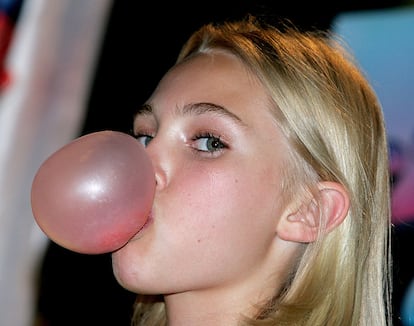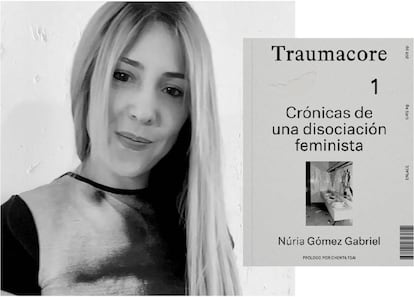**Núria Gómez Gabriel (Barcelona, 1987) is a researcher and cultural communicator. Her practice spans critical pedagogies, contemporary art curating and essay writing.Traumacore, chronicles of a feminist dissociation’ It is his first title in Cielo Santo. You can Follow Núria’s work on Instagram.
“My grandmother used to say that pretty girls chew so much gum that it sticks to their hair and rots inside them,” Xènia projects in class.
–Chewing gum is a gothic accessory –I share–, it doesn’t matter if it’s real or imaginary, tropical or strawberry lemon, it almost always hides a repressed desire. She looks at me straight on without being surprised at all because she got to me on the first day of class and we both feel quite comfortable in the monstrous shadow that chewing gum projects today. That slogan, that little phrase written in Y2K WordArt for the advertisement of the collection of looks that Xènia Rumeu is designing at the university, quickly connects me with what Laure Vega wrote in her literary critique Tea rooms: Ten hours of work, tiredness, three pesetas on class narratives:
“Class bruxism” [género, raza] It is a gesture that is reproduced in the face of the damage of a rough life and that consists of lowering the head, swallowing saliva, gritting the teeth. A gesture that is reproduced in the face of every abuse, every humiliation, every comment in bad taste, every infantilization. Because the answers never given and the voice that is never raised produce a particularly acute type of pain in the soul. A pain in the jaw that does not occur in a few hours, days, or years, but is a pain of a lifetime, of all lives.
–But what exactly do you eat when you chew gum? – I insist on asking.
–A lot of shame –answers Xènia–, a shame that I have been carrying around since the end of secondary school, when I developed an eating disorder. Shame and discomfort. I have a very high tolerance for physical discomfort. I wear heels, my tights fall down, my skirt rides up, my top makes my boobs pop out and people ask me how I put up with it, and the thing is that I can control this discomfort; the other one, the one inside, I get rid of little by little and I lose the shame of not fitting into the moulds that I identify by living life on the street and at university.
We exchange cultural references about the romanticization of chewing gum in the representation of a femininity masked by success and comfort: the meme that went viral by Rosalía in which the singer incorporates the gesture of chewing gum with a disgusted face in her choreographies; the sensuality contained in the bubbles of pin-ups like Frenchy in the film Grease; the conceptual impact of the teenage star that sparked Britney Spears’ second album under the name Oops… I Did It Again; the decorative poster Bunny (Kate Moss Bubblegum) by Michael Moebius and its many variations in which the model appears covered in gum; we also talked about the scene Get Your Gum in Hannah Montana; and Violet Beaurgarde, one of the girls, known for being rude, competitive and self-centered, who won the golden ticket to enter Willy Wonka’s chocolate factory and whose greatest achievement was her status as world junior gum-chewing champion, a title she won by chewing the same gum (her own pride? her dignity?) for three months straight.
Before closing the notebook, I share with Xènia the work of Blanca G. Terán in the performance #realitycow. An aesthetic exercise in which the artist takes the action of chewing gum as a starting point to investigate the experience that she and her co-worker Óscar H. Tristancho call “cow subject”: 20,000 jaw blows and 200 liters of saliva.
My intention is to delve a little into the phenomenon of rumination. Something tells me that the chewing gum industry is growing because one of the experiences that we are most strongly affected by today is rumination. Not only because of the large number of people who regurgitate their food, but because of a mental digestion interruption. It happens that no matter how much you want to stop your thoughts and distract yourself with something else, they are there, lurking. Your mind chews the same worries over and over again, like a piece of gum that you stretch, and it goes back into your mouth without really knowing why. Mistakes made, lost opportunities, things we could have done differently, everything we have the opportunity to say, but that, however, we decide to overshadow by dissociating ourselves from reality. We disconnect and relate to discomfort in a darkly plain and sarcastic way. Repressed thoughts that sometimes fossilize into fuel for that loop of excessive rumination. The same concerns and the same fears in an endless cycle to which the brain becomes addicted when it does not find a resolution to its problems.

e-blowing contest at Planet Hollywood in 2005, in New York.Paul Hawthorne (Getty Images)
It doesn’t matter if you chew it with your mouth open or with a disgusted face, discreetly, going to the gym or in the unemployment queue. Lorena Castell explains that the act of chewing gum can produce two types of reactions: desire or repulsion. Chewing gum thus becomes the perfect gothic accessory for those of us who are unhinged. Ruminants, bruxists, dissociative.
–There are two very different aspects to chewing gum –Xènia explains without a second’s hesitation–, one is chewing gum; and the other is that I never, ever throw the gum away. Not only do I chew it, but I also keep it very close to my body, in my hair. This is accentuated when I am tired and think “what am I doing here? I don’t know if this makes much sense”. Then, it is as if I were wearing the gum. So, big, chained to my body, I have to drag it around, with its lilac pink, metallic colour, it weighs a lot and makes a deafening, iron sound.
It occurs to me to contact Ariadna Parreu regarding the glossary of materials that accompanies his latest sculpture exhibition BOCA BOLA. In our recent collaboration on your sample I was really interested in asking you about the material composition of gum because, as a good lover of soft things (@softknowledge), Ariadne knows that there is something creepy about teeth:
“That amnesiac trauma after sucking, where the inside is outside and the bone shines and hurts. Chewing without swallowing. Gum, a plastic-elastic paste with colors and flavors reminiscent of fruit, a vegetal essence concentrated in a mass of geological temporality. The most used ones do not come from the earthly cavity but from trees, like the white rubber of tires, although its transformation is obscure, or from the deposition of bacteria. Scité ya’, the action of chewing gives its name to the original product, tzictli, the sap of the sapodilla tree obtained with machetes. It could have been called anything, where there were trees, people chewed for self-care by stimulated overproduction of saliva, but this was exploited: the promise of a Creole military hero exiled in the USA, the black market of the Second World War, popularized it. Disposable gum to chew; a collateral by-product of the self-sufficiency fever just in case a war comes.”
Against your mental mouth. So Rankin Carroll proves itdirector of the Mars brand, when he confesses that this year he plans to spend approximately 50 million dollars on the campaign Calm your ‘Mouth Mind’ which claims that chewing gum can silence intrusive thoughts and increase confidence. A little mouth on the forehead stars in the commercial. Orbit is going to be a hit.
–So, those of you who have holidays and can stop working, are you also “cow subjects” in summer? Does rumination disappear or has it set in to mess up your rest and well-being?
–The other day I went to the supermarket and I found two really cute little packages and I put them in my bag.

#Ruminants #bruxists #dissociative #gothic #nature #chewing #gum #today
